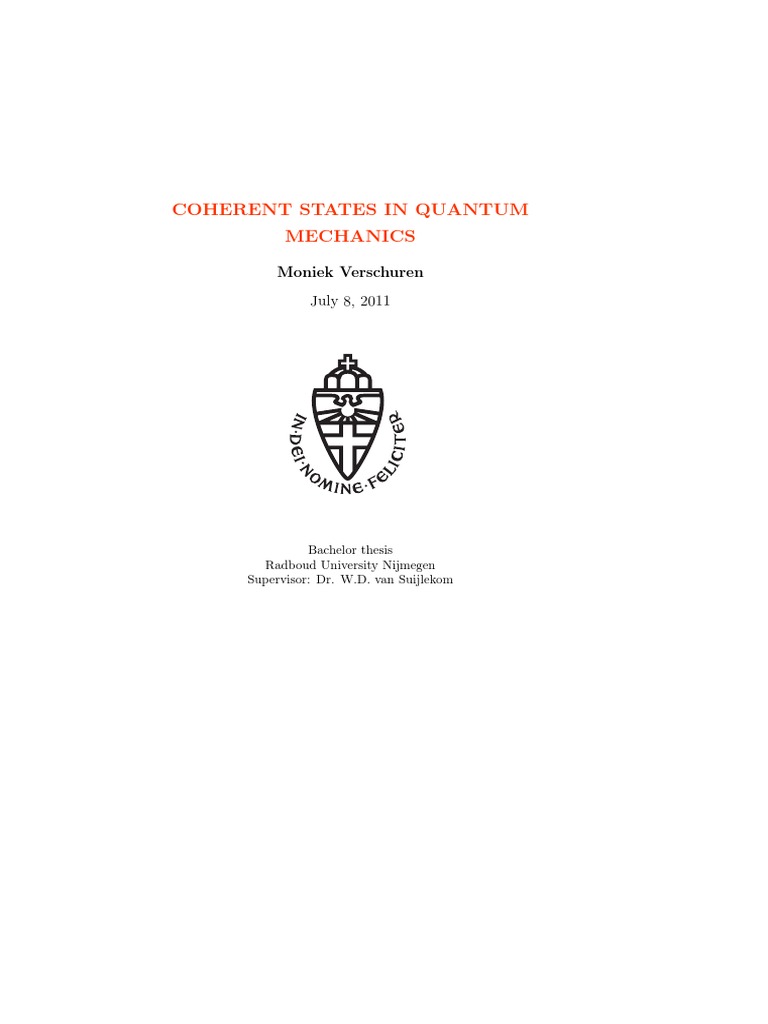The concept of coherent states in quantum optics provides profound insights into the intricate interplay between classical and quantum phenomena. These states, first formulated by Erwin Schrödinger in the 1920s, serve as an essential cornerstone in understanding the behavior of quantum systems, particularly regarding photons and the electromagnetic field. This article delves into the significance of coherent states, emphasizing their implications in quantum optics and beyond.
To commence, it is crucial to delineate what coherent states are. In essence, a coherent state is a specific quantum state of the quantum harmonic oscillator that most closely resembles classical behavior. These states are characterized by a minimal uncertainty product, aligning perfectly with the Heisenberg uncertainty principle while exhibiting distinctive properties akin to classical light waves. This juxtaposition of quantum mechanics with classical physics molds the conceptual foundation pivotal for advancements in quantum optics.
The significance of coherent states becomes increasingly evident when we explore their role in laser physics. Lasers emit light that can be described as a coherent superposition of various quantum states. This results in a beam of light that exhibits phase stability and spectral purity, which is foundational for myriad applications ranging from precision measurement techniques to telecommunications. The high degree of coherence inherent in lasers enhances their utility in applications that demand fine-tuning and robustness, such as holography and quantum information processing.
Furthermore, coherent states are instrumental in elucidating the phenomena of quantum superposition and entanglement. These states form the bedrock for the development of quantum technologies, including quantum computing and quantum cryptography. By harnessing the unique properties of coherent states, physicists can generate entangled photon pairs, facilitating secure communication channels and potentially revolutionizing information transfer paradigms.
The exploration of coherent states extends into the realm of quantum optics experiments. Consider the famous Hong-Ou-Mandel effect, where two indistinguishable photons incident on a beam splitter exhibit a striking interference pattern. The underlying mechanics of this phenomenon are intricately linked to the coherent nature of the photon states involved. The manifestation of such quantum interference underscores the necessity of coherent states in revealing the non-classical properties of light, which serve as a gateway to advanced explorations of quantum mechanics.
In addition to their theoretical prominence, coherent states have practical implications that span multiple disciplines. For instance, in the burgeoning field of quantum metrology, coherent states contribute immensely to developing measurement techniques that surpass classical limits. These methods, reliant on the precise manipulation of coherent light, have profound implications for gravitational wave detection, timekeeping, and imaging. As such, the coherence properties of light are not merely a curiosity; they are vital for pushing the boundaries of measurement accuracy and sensitivity.
Another fascinating aspect of coherent states lies in their connection to the phenomenon of thermal light. By investigating the statistical properties of light emitted from thermal sources, researchers discern that thermal light can be approximated by a mixture of coherent states. This realization bridges the gap between classical thermal radiation and quantum phenomena, allowing for a deeper understanding of equilibrium processes in quantum statistical mechanics. The examination of these quasi-coherent states provides invaluable insights into the behavior of photons in various physical scenarios, thereby enhancing our comprehension of quantum systems.
Moreover, coherent states have significant implications in the emergent field of quantum optics and nonlinear dynamics. The study of photonic interactions in nonlinear optical media often invokes the use of coherent states as a framework for analyzing phenomena such as four-wave mixing and solitons. These interactions showcase the capacity of quantum optics to yield novel effects that resonate with both theoretical intrigue and practical utility.
The educational sphere also benefits from the inclusion of coherent states in curricula concerning quantum mechanics and optical engineering. By teaching students about these states, educators can elucidate fundamental principles of quantum behavior, fostering a more engaging understanding of how quantum theories manifest within classical frameworks. This pedagogical approach aids in sculpting the next generation of scientists equipped with a nuanced grasp of quantum phenomena.
In conclusion, the exploration of coherent states in quantum optics reveals a multifaceted tapestry of theoretical significance and practical applications. These states not only embody the intriguing intersection of classical and quantum physics but also pave the way for advancements in technology and measurement precision. As researchers continue to delve deeper into the nature of coherence in quantum systems, the promises of new paradigms and discoveries remain tantalizingly close. The study of coherent states not only piques curiosity but also serves as a gateway to unraveling the enigmatic complexities of the quantum world, compelling both theoretical inquiry and experimental investigation.












